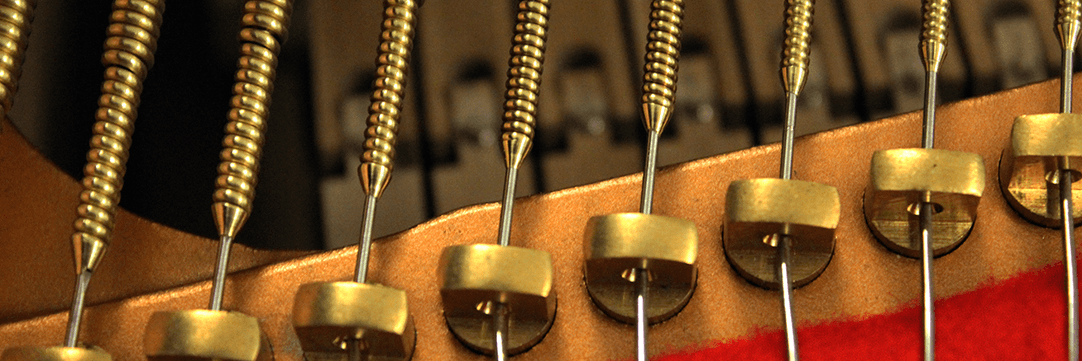Quality Strings designs and fabricates bespoke bass strings for upright and grand pianos
Additionally the plain wire unisons can be improved by rescaling
Our proprietary software brings the entire scale into balance, producing a homogeneous sound
The following are a few examples of scale design we have performed for actual instruments
Scale Design report
After scaling the plain wire unisons, we send our client a three-part report
1 - Graph of the ADSR progression, which determines the string diameters
2 - Graph of the stress rate curve, which determines the selection of materials
3 - List of material types and diameters per key
In what follows we illustrate parts 1 and 2 in relation to actual instruments
1 - ADSR progression (Yamaha C7)
Click here for a more detailed explanation of ADSR
Attack
The time taken from pressing the key to the sound reaching its peak level
Decay
The time taken for the sound to reach its sustain level
Sustain
The level at which the sound remains audible until the string is damped. Not only its volume but also its duration is important
Release
The time taken for the volume to decay to zero after the key is released
Envelope
The entire development of the volume (ADSR) from the moment the key is pressed until the sound dies away
Release is not simply a matter of damping and its regulation. A string with the wrong dimensions can also cause damping problems
We consider the even progression of Attack, Decay, Sustain and Release (ADSR) to be extremely important because this has a major impact on the playability of an instrument
This project was one of the first scales we designed using our improved proprietary software. These were for the plain wire unisons of a Yamaha C7 made in the mid-1970s
The graph of this Yamaha's ADSR progression is shown here
In this instrument, the plain wire unisons begin at key 24 and go all the way to key 88
The higher the ADSR, the stronger the attack and the lower the sustain and vice versa
Our aim is a smooth ADSR progression
Blue line
This was the existing situation. What immediately struck us was the irregular ADSR progression. Between keys 30 and 40 there was enormous attack and little sustain; this was followed by a dip at about key 45, where the attack was less and the sustain a little greater. This in turn was followed by a second peak where the attack increased again and the sustain lagged a long way behind
Red line
The desired ADSR progression
Green line
The new situation: the wire diameters that approach the desired ADSR progression as close as possible. Given that the diameters of the available materials increase by increments of 25 micrometres, this will never be a straight line
The new ADSR progression is far more even
2 - Selection of materials (Bechstein D)
Re-Scaling a 1923 Bechstein D produced the following graph
This graph shows the stress rate curve. The vertical axis represents the percentage of the practical breaking load, while the horizontal axis represents the key numbers
Blue
This was the existing situation
Red
The desired situation
Green
The new situation, which combined Röslau and Paulello wire
Paulello type 1, which is two degrees weaker than Röslau, is used for keys 20 to 24. This increases the stress rate and thus the clarity, so that the sound is much more in balance with the bass. Paulello type 0, one degree weaker than Röslau, is then used for keys 25 to 66. Finally, Röslau was used from key 67
The combination of Paulello and Röslau made it possible to get much closer to the ideal situation and it produced balanced clarity
Click here for a more detailed explanation about Paulello wire
According to Paulello, the stress rate of a string is the most important factor influencing its sound properties and, in particular, its clarity
The percentage of a string's practical breaking load must be within a certain bandwidth in order to obtain a good sound. For modern instruments, this bandwidth begins at about 50% in the bass and goes up to about 80% in the uppermost treble register
Altering the diameter of a plain string has practically no effect on its stress rate. If a larger diameter is used in an attempt to lower this percentage, the string will be able to withstand more tension but this tension will also increase due to the greater diameter and, accordingly, the string's stress rate will barely be altered
To exert a greater influence on this, one could alter the speaking length of the string. It would be far easier, however, to change the composition of the material. Using a weaker material with a lower breaking load, for instance, would increase the stress rate of a string with the same diameter
This is why Paulello has developed five different strengths, known as types
Using a weaker material then makes it possible to reduce the well-known dip in clarity at the break above the bass. The lower breaking load increases the stress rate as well as the clarity of the sound, so that it is more in balance with the bass
It is quite possible to combine the various Paulello types with Röslau within a scale, this is known as hybrid scaling
The regular progression of the stress rate is more important than considerations of inharmonicity, but it is not more important than a smooth ADSR progression. Both these factors have to be brought into balance in order to achieve an ideal result
The result
The scale can be brought into much better balance by combining a smooth ADSR progression with balanced clarity. The result is a
Homogeneous Sound
Less voicing
Having strung the piano to the best possible effect, there will be less need for voicing. The fact is that the new scale will no longer produce major sound differences that need to be evened out
"What a fantastic grand piano it is now! Everything is in balance:
its full rich sound, as well as its depth, transparency and touch
You often hear differences in sound at the breaks,
but not in this instrument
And the incredible amount of sustain it has gotten!
I feel like the king of the castle when I play this piano, what a pleasure!"
Listen to and compare recordings without and with Quality Strings






